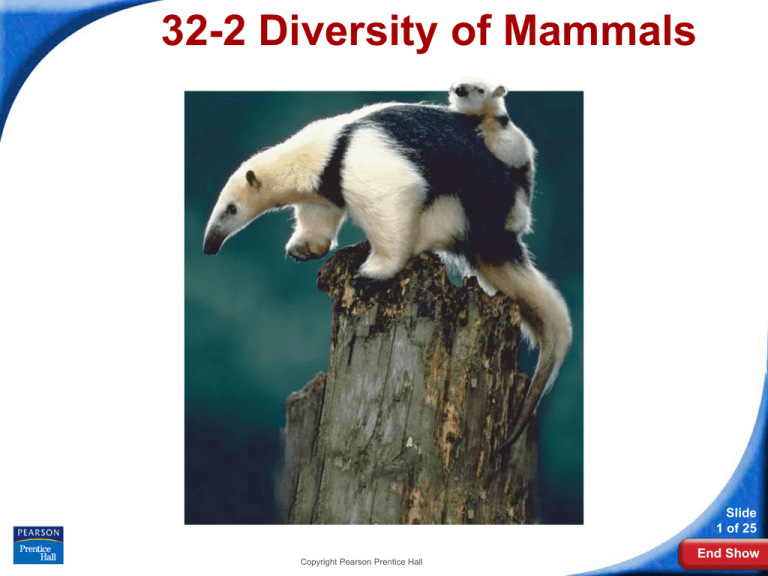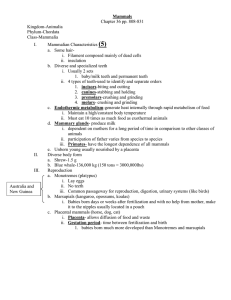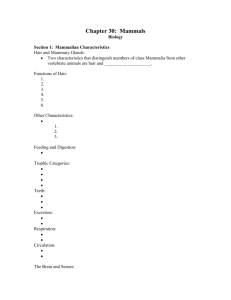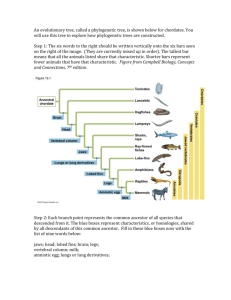32-2 Diversity of Mammals Slide 1 of 25 End Show
advertisement

32-2 Diversity of Mammals Slide 1 of 25 Copyright Pearson Prentice Hall End Show 32-2 Diversity of Mammals Diversity of Mammals The class Mammalia contains about 4500 species. Mammals have the greatest range of size of any group of vertebrates. Tooth structure and the number and kind of bones in the head are used to classify mammals. The most important way to categorize living mammals is by the way they reproduce and develop. The three groups of living mammals are monotremes, marsupials, placentals. Slide 2 of 25 Copyright Pearson Prentice Hall End Show 32-2 Diversity of Mammals Monotremes and Marsupials Monotremes Belong to order monotremata Monotremes, or egg-laying mammals, share two notable characteristics with reptiles: • digestive, reproductive, & urinary systems all open into a cloaca (monotreme means single opening) • females lay soft-shelled eggs that incubate outside the body – the eggs hatch in about 10 days Slide 3 of 25 Copyright Pearson Prentice Hall End Show 32-2 Diversity of Mammals Monotremes and Marsupials Young monotremes are nourished by their mother's milk, which they lick from pores on her abdomen. Only three species of monotremes exist today: the duckbill platypus and two species of spiny anteaters, or echidnas. These animals are found in Australia and New Guinea. Slide 4 of 25 Copyright Pearson Prentice Hall End Show 32-2 Diversity of Mammals Monotremes and Marsupials Marsupials Kangaroos, koalas, and wombats are examples. Marsupials bear live young, but at a very early stage of development. Young marsupials complete their development in an external pouch. When marsupials reproduce, the fertilized egg develops into an embryo inside the mother's reproductive tract. The embryo is born at a very early stage of development. Slide 5 of 25 Copyright Pearson Prentice Hall End Show 32-2 Diversity of Mammals Monotremes and Marsupials Once born, the embryo crawls across its mother's fur and attaches to a nipple. Nipples are located in a pouch called the marsupium on the outside of the mother's body. The embryo spends several months attached to the nipple. The young marsupial will drink milk until it grows enough to survive on its own. Slide 6 of 25 Copyright Pearson Prentice Hall End Show 32-2 Diversity of Mammals Placental Mammals Placental Mammals Mice, cats, dogs, whales, elephants, sea lions, and humans are examples. Placental mammals are named for an internal structure called the placenta, which forms when the embryo's tissues join with tissues from within the mother's body. In placental mammals, nutrients, oxygen, carbon dioxide, and wastes are exchanged efficiently between embryo and mother through the placenta. Slide 7 of 25 Copyright Pearson Prentice Hall End Show 32-2 Diversity of Mammals Placental Mammals The placenta allows the embryo to develop for a longer time inside the mother; from a few weeks in mice to as long as two years in elephants. Most placental mammals care for and nurse their young after birth. Slide 8 of 25 Copyright Pearson Prentice Hall End Show 32-2 Diversity of Mammals Placental Mammals There are 12 universally agreed upon orders of placental mammals. Up to 21 have been debated. Insectivores – order insectivora •Long, narrow snouts and sharp claws •Insect eaters •Tree shrews, hedgehogs, shrews, and moles. •Very high metabolic rates, eat constantly •Sharp claws for digging. Slide 9 of 25 Copyright Pearson Prentice Hall End Show 32-2 Diversity of Mammals Slide 10 of 25 End Show 32-2 Diversity of Mammals Chiropterans (winged mammals) - Order Chiroptera • Bats: second largest order, 925 species. • One quarter of all mammal species. • Eat all kinds of things, insects, fruit, blood (vampire bats) • Night bats use echolocation to find food. • Many bats live in colonies, sleeping together upside down with wings wrapped around their body. Slide 11 of 25 Copyright Pearson Prentice Hall End Show 32-2 Diversity of Mammals Slide 12 of 25 End Show 32-2 Diversity of Mammals Xenarthrans - Order Edentata •Means without teeth; simple teeth without enamel, or no teeth •Sloths, anteaters, armadillos •Sloth: slow-moving, nocturnal mammal that spends most of its life hanging upside-down in trees. •The sloth is an herbivore. The sloth's main defense against predators is to claw and nip at an attacker. •Armadillo are timid, armored mammals Armadillos can jump 3 ft straight up into the air. Armadillos have peg-like teeth. •Anteaters are good swimmers and tree climbers and have a very long, thin tongue. •Anteaters walk on their knuckles, and have long, hook-like claws that do not retract, but curve under the paws when the anteater walks. They catch insects using their long tongue, flicking the tongue in and out up to 160 times each minute. 13 Slide of 25 Copyright Pearson Prentice Hall End Show 32-2 Diversity of Mammals Slide 14 of 25 End Show 32-2 Diversity of Mammals Rodents - Order Rodentia • Largest order of mammals: more than 1700 species • Mice, rats, squirrels, beavers, porcupines, chipmunks and gophers • Have two long front teeth, used for chewing. They grow throughout their life. • Herbivores • Short gestation periods • have a single pair of long, curved incisor teeth Slide 15 of 25 Copyright Pearson Prentice Hall End Show 32-2 Diversity of Mammals Slide 16 of 25 End Show 32-2 Diversity of Mammals Lagomorphs - Order Lagomorpha • Herbivores with two pairs of incisors and hind legs adapted for jumping • Rabbits, pikas and hares • Consists of 65 species • Sharp front teeth • Eat plant material • Short gestation period, produce a lot of young • Pikas have rounded ears and legs of equal length. Slide 17 of 25 Copyright Pearson Prentice Hall End Show 32-2 Diversity of Mammals Slide 18 of 25 End Show 32-2 Diversity of Mammals Carnivores - Order Carnivora • Have sharp claws and teeth that they use to catch, kill, and eat prey. • Meat eaters—exception Panda Bear • 240 species • Cats, dogs, wolves, bears, weasels, hyenas, lions, coyotes and seals • Sharp teeth and claws • Strongest and most intelligent groups of mammals Slide 19 of 25 Copyright Pearson Prentice Hall End Show 32-2 Diversity of Mammals Slide 20 of 25 End Show 32-2 Diversity of Mammals Order Carnivora, Suborder Pinnipeds • Walruses, sea lions, otters, and seals • Swimmers • Thick layer of fat • Return to land to reproduce Slide 21 of 25 Copyright Pearson Prentice Hall End Show 32-2 Diversity of Mammals Slide 22 of 25 End Show 32-2 Diversity of Mammals Cetaceans - Order Cetacea • Aquatic Mammals: whales, dolphins, and porpoises • Must come to the surface to breathe • Torpedo shaped body with a long pointed head and no neck • No gills but have lungs and circulatory system designed for deep, long dives • Subcutaneous fat—blubber, for warmth. • Lost both their external ears and their hind legs • Bear young in water • Most are carnivores, some are plankton eaters. Copyright Pearson Prentice Hall Slide 23 of 25 End Show 32-2 Diversity of Mammals Slide 24 of 25 End Show 32-2 Diversity of Mammals Sirenians - Order Sirenia • Large, slow moving mammals that live in aquatic environments • Related to the elephant • Barrel shaped body • Herbivores • Live in rivers and streams, some in ocean • Manatee, sea cow, dugongs • Inspired legends about mermaids Slide 25 of 25 Copyright Pearson Prentice Hall End Show 32-2 Diversity of Mammals Slide 26 of 25 End Show 32-2 Diversity of Mammals Ungulates - Order Artiodactyla • Hoofed mammals with an even number of toes on each foot • Grazing animals • Cattle, sheep, goats, hippos, giraffes, and pigs. • Two toes on the foot • Flat teeth for grinding food • Have rumen, special structure for to break down cellulose. Slide 27 of 25 Copyright Pearson Prentice Hall End Show 32-2 Diversity of Mammals Slide 28 of 25 End Show 32-2 Diversity of Mammals Placental Mammals Ungulates - Order Perissodactyla • Hoofed mammals with an odd number of toes on each foot • Horses, zebras, tapirs, and rhinoceroses • Odd toed ungulates • Grazers • Flat teeth for grinding food • Have rumen, special structure for to break down cellulose. Slide 29 of 25 Copyright Pearson Prentice Hall End Show 32-2 Diversity of Mammals Slide 30 of 25 End Show 32-2 Diversity of Mammals Proboscideans - Order Proboscidea • Mammals with trunks • Include the African and Indian elephant • African elephant is larger and taller and has larger ears than does the Indian (Asian) elephant. • Large head broad flat ears, thick skin with little hair • Boneless trunk transfers food and water to mouth • Tusks dig up plant roots or pry bark • Herbivores Slide 31 of 25 Copyright Pearson Prentice Hall End Show 32-2 Diversity of Mammals Slide 32 of 25 End Show 32-2 Diversity of Mammals Placental Mammals Primates - Order Primates • Highly developed cerebrum and complex behaviors • 175 species • Have an opposable thumb: enables them to grasp branches and other objects. • Large eyes that face forward • Omnivores • Most developed cerebrum and the most complicated behaviors. • Live in organized social groups. Copyright Pearson Prentice Hall Slide 33 of 25 End Show 32-2 Diversity of Mammals New World Monkeys—live in tees and have long arms for swinging and they use their prehensile tails that they use for grasping Old World Monkeys—Chimps, gorillas: lack tail and many still enjoy the trees. Humans are also considered in this group. Slide 34 of 25 Copyright Pearson Prentice Hall End Show 32-2 Diversity of Mammals Slide 35 of 25 End Show 32-2 Diversity of Mammals Biogeography of Mammals Biogeography of Mammals Earth’s geography has shaped today’s mammals. During the Paleozoic Era, the continents were one large landmass, and mammals could migrate freely across it. As continents drifted apart during the Mesozoic and Cenozoic, ancestors of mammal groups were isolated from one another. Each landmass took with it a unique array of mammal groups. Copyright Pearson Prentice Hall Slide 36 of 25 End Show 32-2 Diversity of Mammals Biogeography of Mammals Similar ecological opportunities on the different continents have produced some striking examples of convergent evolution in mammals. Landmasses merged in the late Cenozoic, and mammals dispersed into new habitats. Living mammals reflect the diversity that resulted. Slide 37 of 25 Copyright Pearson Prentice Hall End Show 32-2 Most mammals are a. monotremes. b. marsupials. c. placental mammals. d. placental marsupials. Slide 38 of 25 End Show Copyright Pearson Prentice Hall 32-2 Monotremes are the only group of mammals that a. lay eggs b. have hair. c. feed their young with milk. d. are endotherms. Slide 39 of 25 End Show Copyright Pearson Prentice Hall 32-2 Rabbits belong to an order of mammals called the a. cetaceans. b. lagomorphs. c. proboscideans. d. chiroptera. Slide 40 of 25 End Show Copyright Pearson Prentice Hall 32-2 Ant-eating mammals on different continents look similar to each other because they are all a. a result of divergent evolution. b. adapted to similar ecological opportunities. c. recently evolved from a common ancestor. d. evolved from an ant-eating reptile. Slide 41 of 25 End Show Copyright Pearson Prentice Hall 32-2 What is the function of the placenta? a. production of milk b. exchange of materials between fetus and mother c. digestion of food d. protection of a young mammal after birth Slide 42 of 25 End Show Copyright Pearson Prentice Hall





